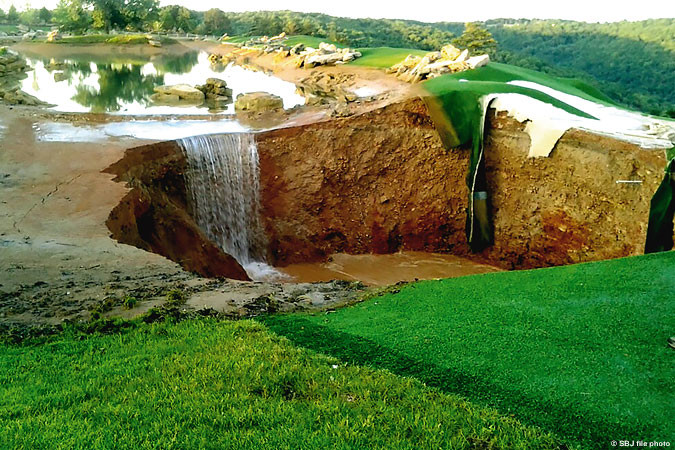The Missouri Department of Natural Resources determined a possible cause for five sinkholes that appeared May 21 at Big Cedar Lodge’s Top of the Rock golf course in Ridgedale, according to a report released by the department’s Environmental Geology Section.
The report suggests the largest of the sinkholes, estimated at 60 feet in diameter and between 30- and 40-feet deep, formed and grew through water infiltration from a surface pond near the course’s driving range.
Bass Pro Shops Director of Conservation Martin MacDonald said the sinkhole has stabilized and isn’t affecting play or practice at the course.
“I don’t know that anyone is ever really going to know what caused it,” said McDonald, adding he has heard several theories on the origins of the sinkhole’s formation, from natural occurrence to heavy rain around the time of the collapse. “This report kind of talks about the potential of a pond liner – that maybe a leak from the pond liner may have triggered it.”
MacDonald said Bass Pro notified DNR of the collapse the day after the sinkholes developed. According to the report, department officials visited Top of the Rock May 28 to observe and provide technical assistance with Bass Pro Facilities Manager Dan Hoy, GeoEngineers Inc. principal Gary Pendergrass and Missouri State University Geography, Geology and Planning Department Director Doug Gouzie.
The DNR report suggests the larger sinkhole be filled with rock to further stabilize it and prevent more collapses in the area, along with the use of a synthetic and clay liner if the pond is to be preserved.
MacDonald said Bass Pro is putting together final recommendations based on the state’s report and studies conducted by GeoEngineers, with an on-site update to be given in two weeks.
“All of the studies have been helpful,” MacDonald said. “We’re still excited about the sinkhole and the geological features beneath, and we will have some exciting news to share soon.”
The DNR report said three known caves are in the vicinity of Top of the Rock, with their alignments matching that of the primary sinkhole. Shortly after the collapse, MacDonald said because water from the sinkhole ended up in one of the caves – known as the Johnny Morris cave, named after the Bass Pro founder - geologists speculated the sinkhole might be part of another cavern or unidentified cave system, according to
Springfield Business Journal archives.
In a July interview with Springfield Business Journal, Morris said the company was conducting seismic testing to determine if the sinkhole and the Top of the Rock cave, where tours are currently conducted, might be connected.
“I’m more excited about it than upset,” said Morris. “I think it would only enhance the Natural History Museum we just opened, which is about geology and the cave trail.
“What it’s done so far is more of an inspiration to go see what’s down there.”
